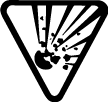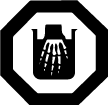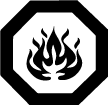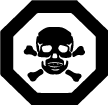Consumer Chemical Products in the Workplace
On this page
- What are consumer products?
- What types of hazards are covered by the consumer product requirements?
- What are examples of consumer chemical product labels and hazard symbols?
- Would using a chemical consumer product be a concern in the workplace?
- Who enforces the use of the consumer chemical products when they are used by the general public?
- Does WHMIS apply to consumer products when they are used in the workplace?
- Who enforces the use of the consumer chemical products when they are used by employers?
- Are all chemical hazards covered by the consumer products regulations?
- What are the employer's responsibilities when using consumer chemical products?
- What are the worker's responsibilities when using consumer chemical products?
What are consumer products?
Back to topConsumer products are those products that individuals are expected to purchase and use for non-commercial purposes, such as for domestic, recreational, and sport purposes. These products are usually available through retail stores or online suppliers. Examples of consumer chemical products are cleaning supplies, adhesives, paints, etc.
They are regulated by the Canada Consumer Product Safety Act and regulations and have requirements for labelling and sale. The risks related to these products are evaluated based on the ingredients, components, parts, accessories, packaging, and estimated lifetime exposures for consumers (not workers).
What types of hazards are covered by the consumer product requirements?
Back to topSome consumer products are hazardous. For example, the Consumer Chemicals and Containers Regulations defines consumer chemical products as:
- a toxic product
- a corrosive product
- a flammable product, or
- a quick skin-bonding adhesive
Consult the regulations for exclusions and more details. For example, a “toxic product” is defined as a product that:
"(a) is capable of causing a lethal effect on a human;
(b )is capable of causing a serious and irreversible but non-lethal effect on a human, such as a depressed level of consciousness, muscular weakness or paralysis, acute renal or hepatic failure, arrhythmia, hypotension, dyspnea, respiratory depression, pulmonary edema or optic neuritis;
or
(c) is identified in Part 1 as a Category 1 toxic product.”
What are examples of consumer chemical product labels and hazard symbols?
Back to topFive main hazard classes are covered by consumer chemical product legislation: toxic products, corrosive products, flammable products, quick skin-bonding adhesives, and pressurized containers. The Consumer Chemicals and Containers Regulations list the labelling and informational requirements for these products. For example, the label is to provide information about the hazard, precautionary and first aid measures, and other instructions.
On the consumer product, the safety related information such as hazard symbols, warning statements, and first aid measures is to be contained within a border that is easily identified from the rest of the information on the label.
There are four hazard symbols. Three symbols indicate the hazard of the product itself (i.e., corrosive, flammable, or toxic shown in a hexagon shape), and one indicates the hazard of the container (exploding object shown in an upside-down triangle). Not all hazardous consumer products require a hazard symbol (e.g., quick skin-bonding adhesives).
The label also uses signal words underneath the symbol which are:
- CAUTION means temporary injury may result. Death may occur with extreme exposure.
- DANGER means may cause temporary or permanent injury, or death.
- EXTREME DANGER means exposure to very low amounts may cause death or serious injury.
Table 1: Consumer Product Hazard Symbols

|
Explosive |
The container can explode if heated or punctured. Flying pieces of metal or plastic from the container can cause serious injury, especially to your eyes. |
|---|---|---|
 |
Corrosive | The product can burn your skin or eyes. If swallowed, it can damage your throat and stomach. |
 |
Flammable | The product or its fumes will catch fire easily if it is near heat, flames, or sparks. Rags used with this product may begin to burn on their own. |
 |
Poison | If you swallow, lick, or in some cases, breathe in the chemical, you could become very sick or die. |
From: Health Canada, 2020. Use household chemicals safely https://www.canada.ca/en/health-canada/services/home-safety/household-chemical-safety.html
Would using a chemical consumer product be a concern in the workplace?
Back to topYes, it can be. A concern is that consumer products are evaluated with the idea that the product is intended to be used sporadically and for short periods. For example, when cleaning is performed in the home on occasion for a short period of time. However, if the same product is used to clean a workplace, or when an individual is employed as a cleaner, the individual may be exposed to the product many hours a day, every day, making the risk of health effects greater.
Another example is bleach. Bleach is corrosive and is sold as both a consumer and industrial product. Regardless of where it is used, the fact that it is packed in smaller quantities for home use does not make it safer to use.
Who enforces the use of the consumer chemical products when they are used by the general public?
Back to topThe use of consumer chemical products by the members of the general public at their residence is not regulated because the legislation requires consumer chemicals products to be packaged and labelled in way that encourages safe use. For example, there is a requirement for containers that are less than 5 litres to be child-resistant.
NOTE: If you have concerns or wish to report side effects, injuries, or other product-related health and safety concerns related to consumer products, please contact Health Canada and use the links to their services. If you are suffering from a health effect or a serious injury related to a product, you should contact your doctor, health professional, local health authority, or poison control centre. Inform the medical staff which products you may have been exposed to.
Does WHMIS apply to consumer products when they are used in the workplace?
Back to topConsumer products are partially exempt from the requirements of the Workplace Hazardous Materials Information System (WHMIS). The Federal Hazardous Products Act and regulations state that suppliers do not have to apply WHMIS compliant labels or provide a safety data sheet (SDS) for these products. In addition, provincial or territorial WHMIS legislation usually exempts employers from the need to obtain an SDS for consumer products.
However, provincial or territorial occupational health and safety legislation does require employers to provide a safe workplace, and this requirement would include education and training about the health effects, safe use, storage, and disposal of products used in the workplace such as consumer chemical products.
Who enforces the use of the consumer chemical products when they are used by employers?
Back to topWhen these products are purchased by employers for use at the workplace, the products are then considered to be regulated under the WHMIS regulations. Improper use, handling, or storage of consumer chemical products at workplaces can be enforced by your jurisdictional health and safety department.
Are all chemical hazards covered by the consumer products regulations?
Back to topNo. In comparison, WHMIS includes more classes. The Canada Consumer Product Safety Act and regulations cover 5 hazard classes while WHMIS covers 31 hazard classes, meaning some hazards classified and communicated by WHMIS may not be covered by consumer product requirements.
What are the employer's responsibilities when using consumer chemical products?
Back to topIf consumer products are used in the workplace, employers are required to provide workers with education and training about their health risk, any handling, use, or storage safe work practices, emergency response, first aid, etc. If workers use both consumer products and WHMIS hazardous products, workers will need to understand both sets of hazard symbols (i.e., both the consumer symbols and WHMIS pictograms)
Employers may wish to purchase products that are intended for sale in the workplace; thus, the product would be provided with WHMIS labelling and a Safety Data Sheet (SDS). SDSs provide more detailed information about the ingredients, exposure, controls, emergency response, first aid, incompatible products, etc. Education and training of workers who work with these products would then be covered when following WHMIS requirements.
If your workplace only requires use of consumer product, for example cleaning supplies:
- Conduct a hazard identification and risk assessment of the workplace to look for all products that may be present and determining any risks associated with those products
- Develop and implement a safe use of consumer chemical products policy and program
- Keep an accurate inventory of all of the products on site
- While an SDS is not mandatory for consumer products, try to obtain a safety data sheet for all products. Many manufacturers have prepared an SDS as a service for their customers. If an SDS is not available, search for information about the products (or their ingredients) using reliable sources
- Make sure that labels remain on the product containers and are readable.
- Educate and train workers about health hazards, emergency procedures, first aid, and in the safe use, handling, and storage of the products they use, or that may be in the area they work.
- Monitor and continually improve your program.
In addition, other elements similar to those in a WHMIS program may be necessary.
What are the worker's responsibilities when using consumer chemical products?
Back to topAs a worker, your responsibilities may include to:
- Participate in the education and training.
- Follow instructions and safe work procedures.
- Be familiar with all products you are handling or to which you may be exposed (such as during a spill or fire). Do not use a product unless you have been trained in safe work procedures.
- Always check the label for instructions before use. Ensure that labels are in good condition. Do not use products without labels.
- Know how to access more information (such as health information, first aid, or safe work procedures), and understand that information
- Ask your supervisor, manager or health and safety committee (or representative) for help if you have questions. You can also contact these groups if you have any concerns. If your concerns are not addressed, you may wish to contact your jurisdictional health and safety department for more guidance.
- Fact sheet last revised: 2021-11-25

